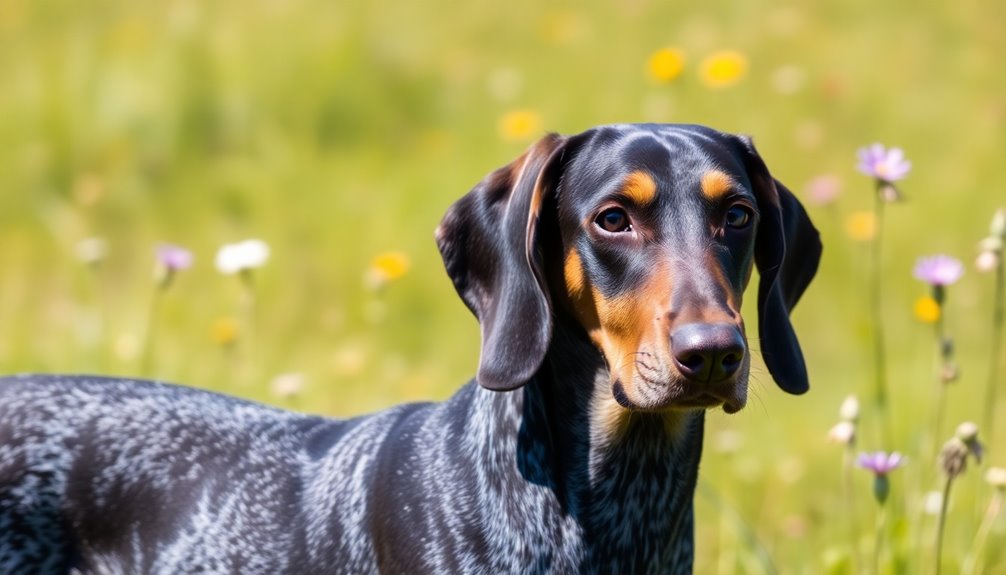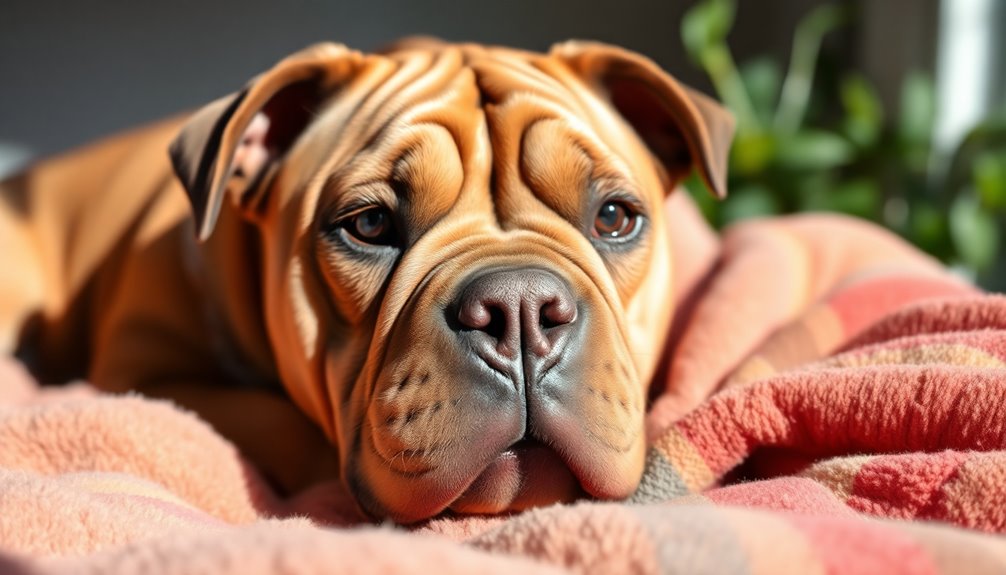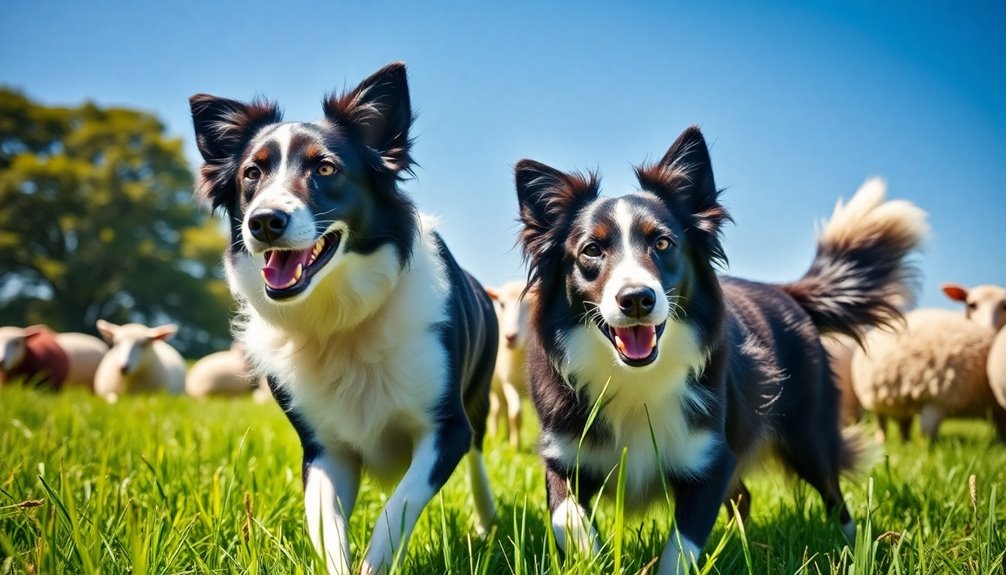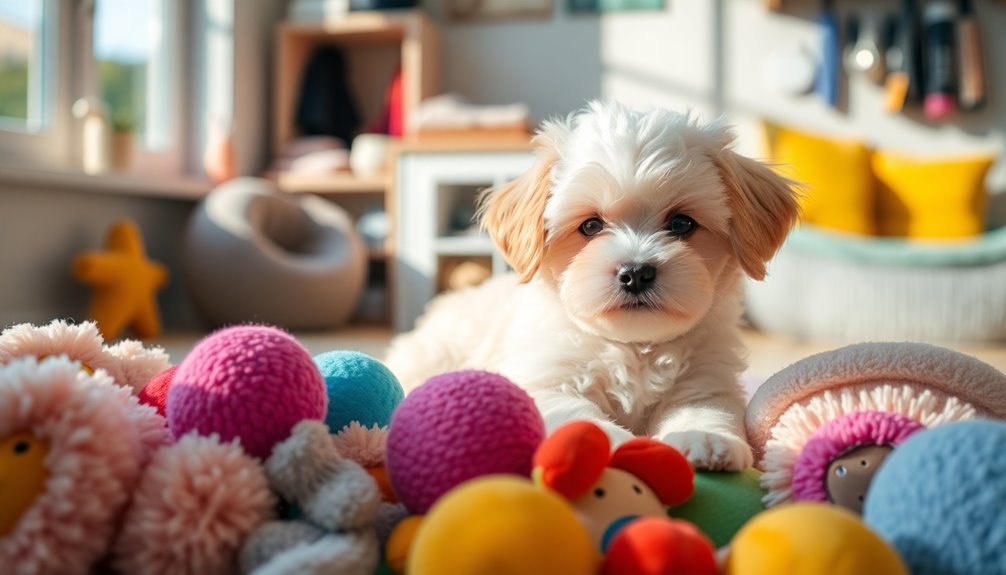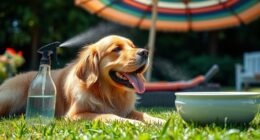The Bluetick Coonhound's loyalty and spirited nature make it a perfect companion for active families. Standing 21-27 inches tall, these dogs are not only striking with their blue-ticked coats but also exceptional hunters thanks to their strong scent-tracking abilities. They're playful and affectionate, thriving on social interaction and regular exercise—aim for 60-90 minutes daily. While they're great with older children, their independent streak requires patience in training. With a lifespan of 11-12 years, investing in their health is key. Discover how to best care for and enjoy this spirited breed as you continue exploring their characteristics.
Key Takeaways
- Bluetick Coonhounds are known for their loyalty, making them excellent companions for families and individuals alike.
- This breed is energetic and requires 60-90 minutes of daily exercise to stay healthy and happy.
- With a playful and affectionate nature, they thrive on interaction and bonding with their human family members.
- Their strong prey drive necessitates proper socialization, especially around smaller pets, to ensure harmonious living.
- Bluetick Coonhounds possess exceptional scent-tracking abilities, making them skilled hunters and trackers in various environments.
Introduction
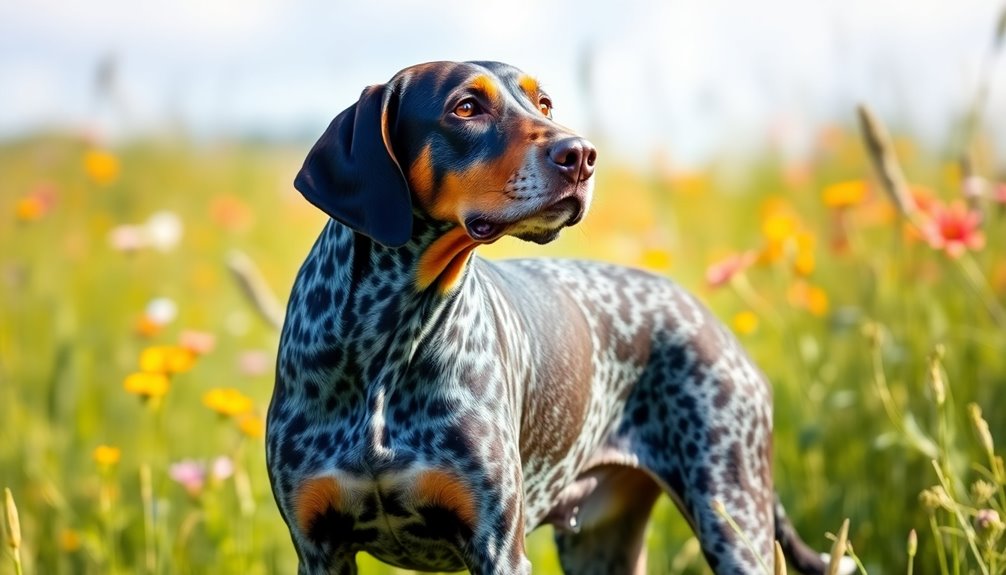
The Bluetick Coonhound is a remarkable breed known for its loyalty and hunting prowess. These dogs typically stand between 22 to 27 inches tall for males and 21 to 25 inches for females, weighing between 55 to 80 pounds and 45 to 65 pounds, respectively.
Their muscular legs and rounded, cat-like feet, complete with tough pads, make them agile and hardy companions. Additionally, their average lifespan is around 11 to 12 years, so planning for their long-term care is essential.
With a short, smooth coat that's both weather-resistant and strikingly beautiful, they usually sport a blue-ticked pattern, sometimes accented with tan or black spots.
Their affectionate nature makes them wonderful family pets, especially for those with older children. However, be prepared for their high energy levels; they thrive in active households where they can run and play.
While their vocal baying can be music to the ears of some, it mightn't suit all environments.
Their strong prey drive means they may see smaller pets as potential quarry, so socialization is key.
History and Origin
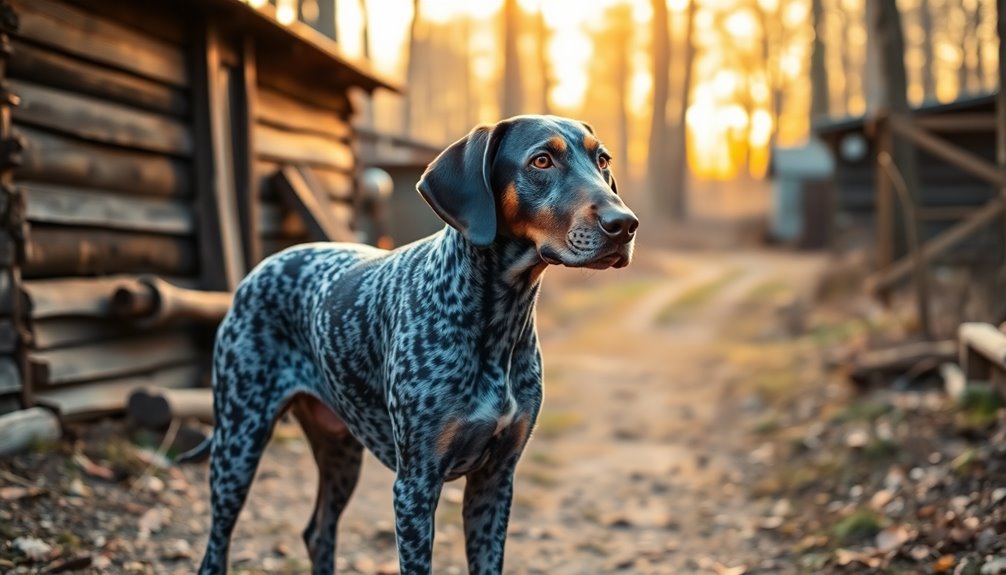
The Bluetick Coonhound traces its roots back to the colonial era in the United States, where it was developed for hunting in challenging terrains. Originating in Louisiana, this breed was specifically bred to track game animals like raccoons, showcasing its impressive scenting abilities. Understanding its history provides insight into why this dog remains a favorite among hunters today. The breed's development draws from French hounds and English foxhounds, which contributes to its distinct characteristics and hunting prowess.
Where and when the breed originated
Originating in the Southeastern United States, the Bluetick Coonhound has a rich history that dates back to the colonial era. You'll find that its roots are deeply entwined with the French hounds brought over by early European settlers, particularly in Louisiana. These settlers aimed to create a versatile hunting dog capable of thriving in diverse and challenging terrains.
As you explore the breed's lineage, you'll note it descends from the Grand Bleu de Gascogne, with influences from English Foxhounds, American Foxhounds, and various Virginia Hounds. This mix was essential for developing the Bluetick's unique hunting traits. The breed is known for its muscular and speedy build, which contributes to its effectiveness as a hunting companion.
Interestingly, George Washington received some of these French hounds as gifts, which significantly impacted the breed's evolution.
The Bluetick Coonhound was initially registered under the categories of English Foxhound and Coonhound in the United Kennel Club. However, it gained recognition as a separate breed in 1946.
The American Kennel Club officially acknowledged the breed in April 2009, allowing it to participate in coonhound events starting in December 2009, highlighting its valued role as both a hunter and a loyal companion.
Tracking Game Animals
With a rich history rooted in hunting, Bluetick Coonhounds have developed impressive tracking abilities that make them stand out among breeds.
You'll find that their keen sense of smell is one of the strongest among all dogs, allowing them to pick up scents, even those that are days old. Their endurance and stamina mean they can track game tirelessly for miles, while their speed and agility let them navigate through challenging terrain with ease. Additionally, their exceptional raccoon hunting abilities are a significant reason for their popularity among hunters worldwide. Heat pumps, known for their energy efficiency, can also support outdoor activities by maintaining comfortable temperatures in hunting lodges.
Training these dogs involves introducing them to game scents using a drag line or scent lure. As they master this, you'll reward them for following the scent, gradually increasing the trail's difficulty.
Real-life practice with experienced hunters or local clubs sharpens their skills further.
Experts at treeing, Bluetick Coonhounds force raccoons up trees, making it easier for you as a hunter to locate your quarry.
Their distinct baying voice not only helps you keep track of them but also signals when they've treed a prey.
With consistent training and positive reinforcement, these loyal companions excel in scent-based hunting, adapting to various prey and proving effective even at night.
Physical Characteristics
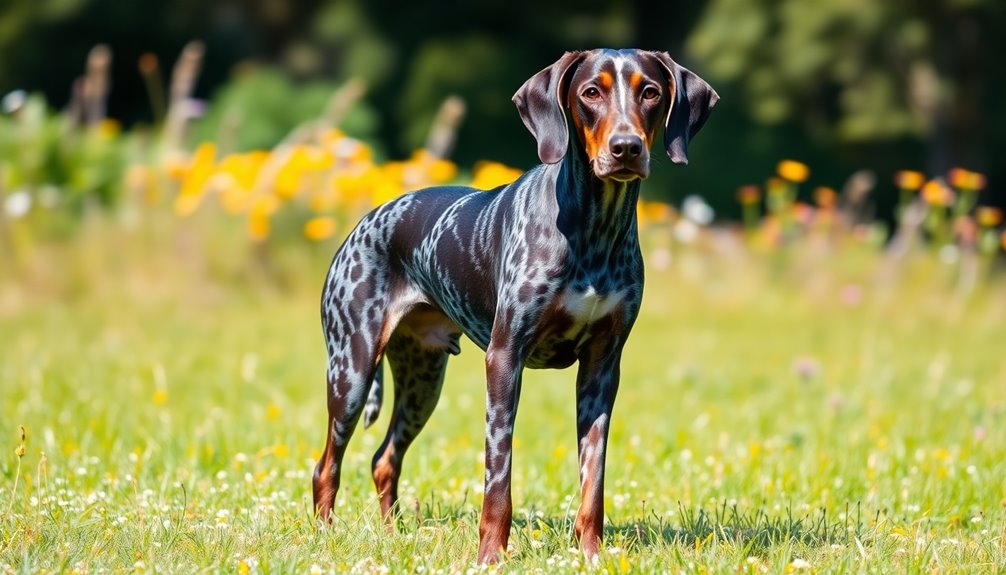
When you look at a Bluetick Coonhound, you'll notice their impressive size and weight, with males standing 22 to 27 inches tall and females 21 to 25 inches. They typically reach their full height by 12 to 14 months of age, showcasing their growth potential early on. Their striking coat features a short, smooth texture, often showcasing blue ticking that gives them a unique appearance. Plus, their large, expressive dark eyes add to their charm, making them not just loyal companions, but eye-catching ones too.
Size, weight, and coat details
The Bluetick Coonhound stands out with its impressive size and striking coat, making it a distinctive presence among dog breeds. Males typically range from 22 to 27 inches in height, while females are slightly smaller, standing between 21 to 25 inches.
In terms of weight, males usually weigh between 55 to 80 pounds, and females range from 45 to 65 pounds. Puppies grow rapidly, reaching close to their adult height and weight by 12 months, but they'll achieve full muscle development by around 2 years.
Their coat is another defining feature, characterized by a short, smooth, and glossy texture. You'll notice the unique "ticked" pattern in shades of blue and black, often with tan highlights. The breed's popularity as hunting and family dogs contributes to its stable population trends.
While they do shed moderately, keeping their coat healthy requires only routine grooming.
Large, Expressive Dark Eyes
Bluetick Coonhounds captivate with their large, expressive dark eyes that play a crucial role in their charm and communication. These round, wide-set eyes are typically a rich brown, with a darker shade preferred, giving them a clear and alert appearance. Their expressiveness adds significantly to the overall appeal of the breed, often reflecting a pleading expression that draws you in.
You'll notice how these eyes convey a range of emotions, from affection and loyalty at home to determination and ambition during hunts. Their exceptional eyesight isn't just about looks; it's functional too. It aids in tracking scents and detecting quarry, enhancing their hunting efficiency. The clear eyesight allows them to navigate well, especially in low-light conditions, which is critical for their hunting performance. Additionally, their eyes communicate alertness and affection, making them well-suited for close relationships with humans.
As you interact with a Bluetick Coonhound, you'll find that their eyes enhance the bond between you and your furry friend. They express curiosity and focus, showcasing their intelligent and loving personality. With every glance, they communicate their feelings and intentions, making those large, dark eyes an essential part of what makes this breed so special.
Temperament and Personality
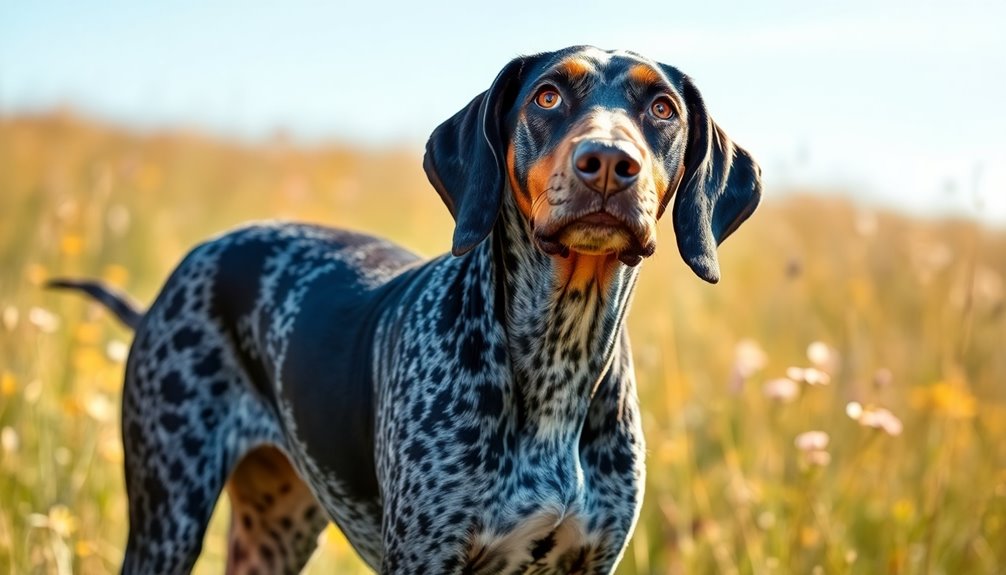
Bluetick Coonhounds have a playful and adventurous spirit that makes them a joy to be around. They're great companions for families, individuals, and even other pets, as long as you provide the right environment and socialization. With their energetic nature, they thrive in active households where they can explore and engage with their surroundings. These dogs require 60-90 minutes of exercise daily to keep them happy and healthy.
Playful and Adventurous Spirit
When you bring a Bluetick Coonhound into your life, you're welcoming a dog with an infectious playful nature and an adventurous spirit. These dogs thrive on affection and enjoy interactive play that challenges their minds and bodies. Activities like fetch and agility exercises are essential to keep them physically and mentally stimulated. A good romp outside or marathon play sessions will make their tails wag with joy.
Bred for hunting, Bluetick Coonhounds have a natural desire for adventure. They flourish in active households that embrace outdoor activities like hiking and road trips. Their strong scenting abilities make them excel in tracking and scent work, providing an outlet for their high energy levels. Their friendly and loyal temperament also makes them great family companions who bond closely with their human family members.
To keep them happy and healthy, you need to engage their minds and bodies regularly. Daily walks, playtime, and mentally stimulating activities are crucial. Canine sports, obedience training, and hunting trials are fantastic ways to channel their energy.
Just remember that their playful spirit requires consistent engagement to prevent boredom and potential behavioral issues. With a Bluetick Coonhound, you'll experience a delightful companion eager for adventure and play!
Suitability for families, individuals, or other pets
With their friendly demeanor and loyal nature, Bluetick Coonhounds make excellent companions for families, individuals, and other pets alike.
They're particularly well-suited for families with children, as they're patient, gentle, and protective. Their high energy levels mean they require regular exercise, which can be a great way for families to bond. Consistent training and early socialization are essential to help them adapt to family life. Their strong sense of smell also makes them engaging partners for outdoor activities like hiking.
For individuals, Blueticks can thrive, but you'll need to provide plenty of physical activity and mental stimulation. They can be independent and occasionally stubborn, so experienced owners who can manage their strong will are ideal. A rural setting or a home with a fenced backyard is best for their needs.
When it comes to other pets, Bluetick Coonhounds generally get along well with dogs of similar energy levels. However, their high prey drive may pose challenges with smaller animals. Proper introduction and supervision during interactions can help them coexist peacefully.
Just keep in mind that they need companionship and can become bored or destructive if left alone for too long. Overall, with the right environment and care, Bluetick Coonhounds make wonderful companions.
Health and Lifespan
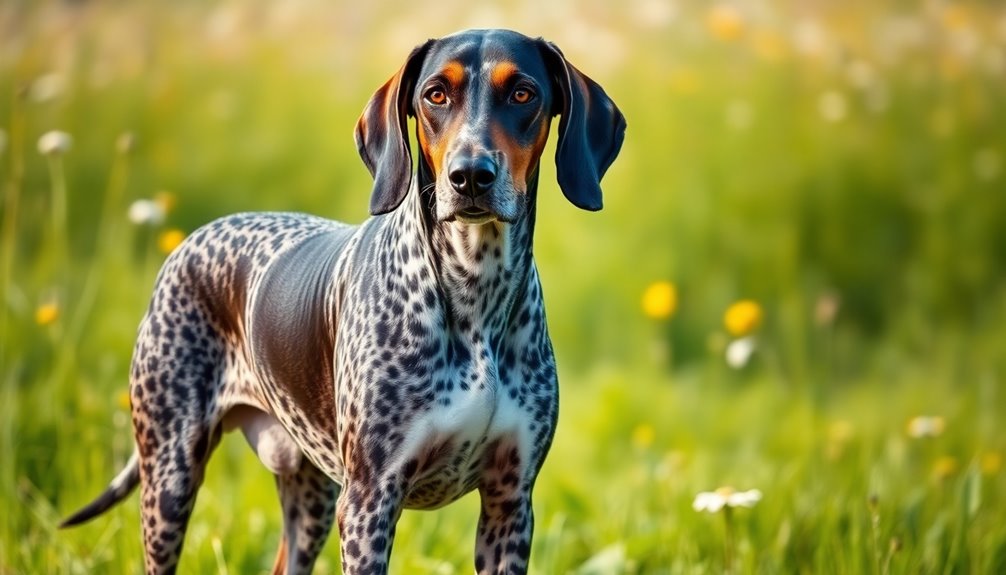
When you bring a Bluetick Coonhound into your life, you can expect a typical lifespan of 11 to 12 years. However, it's important to be aware of common health concerns like hip dysplasia and certain genetic predispositions that may affect your dog. Regular exercise is crucial for maintaining a healthy weight and preventing obesity-related issues.
Typical lifespan of the breed
The Bluetick Coonhound exemplifies loyalty and vitality, often living an average lifespan of 11 to 12 years. This lifespan is typical for medium-to-large-sized dogs, and you'll find that it aligns with their breed category.
Males usually stand between 22 to 27 inches tall and weigh 55 to 80 pounds, while females range from 21 to 25 inches and 45 to 65 pounds.
You can plan on sharing just over a decade with your Bluetick, as they're generally healthy within this lifespan range. To help maximize their longevity, focus on proper veterinary care, a balanced diet, and regular exercise.
Maintaining a healthy weight is crucial, as is responsible breeding, which can enhance the breed's overall health. Additionally, be mindful of ear infections, which can affect their well-being if not properly managed.
Regular veterinary check-ups and active lifestyles contribute significantly to their longevity. While size doesn't significantly affect their lifespan, your commitment to their health can make a meaningful difference.
Common health concerns or genetic predispositions
Owning a Bluetick Coonhound means being aware of several common health concerns and genetic predispositions that can affect your dog's well-being. One significant issue is hip dysplasia, which can lead to arthritis and mobility problems.
You should also watch for luxating patellas, where the kneecap slips out of place, causing pain. Autoimmune thyroiditis is another concern, potentially leading to hypothyroidism.
Eye conditions like cataracts, ectropion, and entropion can cause discomfort and vision problems. Neurologically, be cautious of neuronal ceroid lipofuscinosis (NCL), a progressive disease that can result in leg weakness and vision loss. There's currently no effective treatment for NCL, making genetic testing essential for breeding decisions.
Additionally, be aware of blood disorders like Pelger-Huet anomaly, which can be fatal in homozygous puppies. Gastric torsion, or bloat, is a life-threatening emergency that requires immediate attention.
Dental disease, ear infections, and skin fold dermatitis can also affect your Bluetick Coonhound. Lastly, this breed is predisposed to certain cancers at a younger age, so regular veterinary check-ups are crucial for early detection and treatment. Furthermore, maintaining a healthy weight is essential to prevent obesity-related issues that may exacerbate these health concerns.
Tips for maintaining health and wellness
Maintaining the health and wellness of your Bluetick Coonhound is vital for ensuring a long and happy life. Start by providing high-quality dog food rich in proteins to support their energetic lifestyle and maintain muscle mass. Balance this with carbohydrates and fats for energy, and consider low-fat options to prevent weight gain, especially if your dog is less active. Fresh food can enhance digestibility and minimize food sensitivities.
Regular exercise is crucial. Aim for consistent activity without overdoing it, particularly in the beginning. Incorporate mental stimulation to keep your dog engaged, and take advantage of enjoyable activities like swimming. Always walk on a leash to prevent them from chasing after interesting scents. Energetic dogs like Bluetick Coonhounds thrive on regular physical activity to maintain their overall health.
Don't forget grooming and personal care. Brush your dog weekly to manage shedding, and maintain dental health by brushing their teeth at least twice a week. Weekly ear cleaning is essential to prevent infections.
Routine veterinary check-ups are also important. Keep up with vaccinations and monitor for any abnormal symptoms.
Lastly, ensure your Bluetick has access to fresh water and a comfortable environment for rest.
Care Requirements
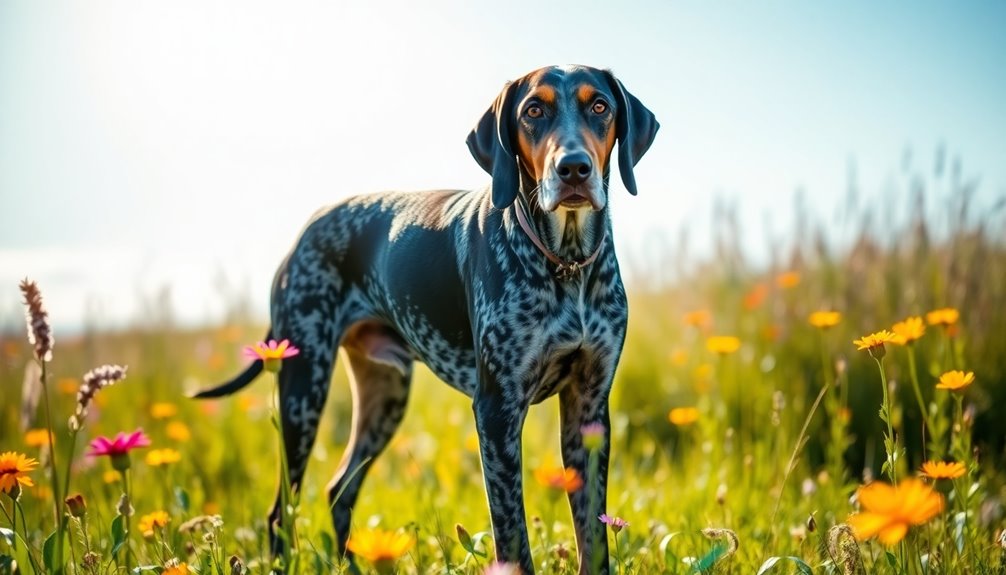
Caring for your Bluetick Coonhound involves meeting their grooming, exercise, and dietary needs.
With minimal shedding, keeping their coat healthy is easy, but you'll still need to provide regular exercise to match their high energy levels. Additionally, focusing on a balanced diet will help keep your loyal companion happy and healthy. To support their high exercise needs, engaging in daily activities like long walks or scent tracking games is essential.
Minimal Shedding, Easy Grooming
When it comes to grooming, Bluetick Coonhounds are relatively low-maintenance, making them a great choice for busy pet owners. They experience moderate shedding year-round, with increased shedding during spring and fall. Since their coat lacks a thick undercoat, you'll find that while shedding is noticeable, it's less than in breeds known for heavy shedding. Bluetick Coonhounds exhibit a distinctive blueticked coat that helps shed dirt and debris while maintaining functional qualities.
To keep their coat healthy, brush your Bluetick 2-3 times a week using a hound glove or medium-bristle brush. This routine helps remove loose fur, distribute natural oils, and prevent matting. Bathing is typically needed every 4-6 weeks, or as required, using a dog-specific shampoo. Be sure to rinse thoroughly to avoid skin irritation.
Regular grooming also involves checking and cleaning their ears weekly to prevent infections and looking for ticks or sores. Keep an eye on their eyes for debris, especially after outdoor play.
For healthy skin and coat, a balanced diet rich in essential fatty acids is key. With these simple grooming practices, your Bluetick will maintain a glossy, healthy coat while you enjoy more time together.
Exercise requirements and energy levels
Bluetick Coonhounds thrive on physical activity, requiring at least 30 to 60 minutes of exercise each day. You can engage them in activities like walking, running, and playing, but consider hiking and jogging to tap into their natural stamina and endurance. They love activities that mimic traditional hunting tasks, so tracking exercises can be particularly fulfilling. Their strong prey drive makes it essential to keep them focused during these activities.
In addition to physical exercise, mental stimulation is crucial to keep them happy and prevent boredom-related behavioral issues. Challenge them with scent, obedience, and agility training. Puzzle toys that dispense treats can keep their minds sharp, while interactive games like hide-and-seek will engage their natural instincts. Engaging in regular puppy training classes can also provide a structured environment for learning.
DIY mental challenges, such as creating obstacle courses or teaching new tricks, can also be beneficial. Managing their energy levels is essential. Secure, fenced areas are a must to prevent wandering, and you should always keep them leashed during walks, especially in wildlife-rich areas.
Monitor their activity levels and channel their energy positively through structured training sessions. By providing sufficient exercise and mental challenges, you ensure your Bluetick Coonhound remains a happy and well-adjusted companion.
Feeding tips and diet recommendations
To keep your Bluetick Coonhound healthy and thriving, focus on providing a balanced diet tailored to their nutritional needs. Adult Bluetick Coonhounds require food with 20-30% protein, with real meat like chicken or beef as the primary ingredient. Healthy fats should make up about 8-15% of their intake. It's crucial to avoid fillers like corn and soy, which don't offer much nutritional value.
Opt for high-quality dog food that combines protein, fat, and carbohydrates. Protein impacts all body functions, while dietary fat provides essential energy. Carbohydrates from vegetables and fruits contribute fiber and antioxidants, promoting overall health. Additionally, regular vet visits can help monitor their overall health and ensure their dietary needs are being met properly.
If you're considering a raw food diet, include meat, bone, offal, and plant ingredients to mimic their natural diet. Consult your veterinarian to determine the best diet and portion sizes based on your dog's age and activity level.
Feed measured meals, ideally in two servings per day, to prevent overeating and obesity. Always ensure fresh water is available, and keep track of their weight to maintain an ideal body condition. Being mindful of these factors will help your Bluetick Coonhound stay fit and happy.
Training and Socialization
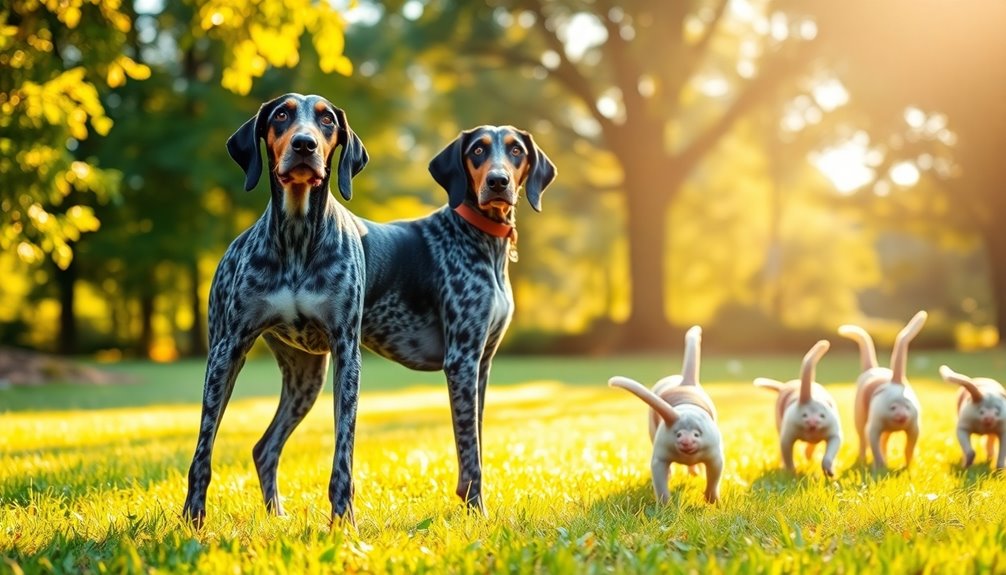
Training your Bluetick Coonhound may require a bit of patience due to their moderately independent nature. Engaging in scent activities can significantly enhance their focus and make training more enjoyable, as these dogs have a natural inclination for scent work. As you introduce them to new friends and environments, take it slow to ensure they feel comfortable and confident. Also, be prepared to address leash pulling during walks to create a more enjoyable experience for both of you.
Moderately Independent Training Style
When it comes to teaching a Bluetick Coonhound, you'll quickly notice their moderately independent nature. This breed thrives on positive reinforcement, so reward good behavior with treats, praise, or playtime to encourage desired actions.
Keep training sessions short—around 10 to 15 minutes—to maintain their focus and enthusiasm. Consistency is key; use the same commands and rewards each time to ensure clarity.
Be patient; training takes time, and you shouldn't expect immediate results. Avoid harsh corrections or negative reinforcement, as these can create anxiety and distrust. Instead, customize your training approach to your dog's unique personality and leverage their natural instincts by incorporating scent work and tracking exercises. Incorporating basic obedience commands early on will provide a strong foundation for their training.
Set clear boundaries to manage their independent behavior, and don't hesitate to seek professional help if needed—especially from trainers experienced with hounds.
Daily vigorous exercise is essential, so provide at least an hour of brisk walks or play. Engage their minds with puzzle toys and interactive games, balancing physical activity with relaxation to prevent hyperactivity.
Gradual Introductions to New Friends
Gradual introductions are crucial for helping your Bluetick Coonhound form positive relationships with new friends, both canine and human. Start these introductions in a neutral area to minimize any territorial behaviors. Keep the initial distance where the dogs can see each other but avoid direct interaction. Use high-value treats to encourage positive behavior during this phase.
Always monitor their body language for signs of stress or aggression, such as hair standing up or growling. If you notice any concerning signals, be ready to intervene. Reward calm behavior with treats and praise to reinforce these positive interactions. Gradually decrease the distance between the dogs while maintaining a calm atmosphere. Dogs should meet in a neutral territory to ensure that both feel safe and relaxed.
For socialization, begin early—ideally during the puppy stage—to help your Bluetick develop confidence and social skills. Expose your dog to various environments, people, and other animals. Participating in organized gatherings like dog meet-ups can provide diverse social experiences.
Ensure every interaction remains positive to foster well-adjusted behavior. Remember, the key is to increase the variety of experiences gradually, preventing your Bluetick from feeling overwhelmed. With patience and consistency, your Bluetick will thrive in social settings.
Leash Pulling During Walks
Leash pulling can transform a simple walk into a frustrating experience for both you and your Bluetick Coonhound. To tackle this, start with the stopping method—stop walking immediately when your dog pulls, waiting for them to return to a neutral position before moving on.
You can also use leash corrections by gently pulling up on the leash and releasing it to reposition your dog, repeating as necessary. Changing direction can help too; turn 180 degrees when they pull, encouraging them to follow you. Loose leash walking promotes a relaxed environment, preventing reactive behavior towards distractions and ensuring a more enjoyable experience for both you and your dog. This method can help develop the guidance and support needed for effective training.
Positive reinforcement is key. Reward your dog with treats or praise for walking nicely beside you. Consistency is crucial since Bluetick Coonhounds can be independent.
When introducing the leash and harness, do it gradually with treats to create a positive association. Start training in familiar, distraction-free areas, and consider using long leashes to give your dog some freedom while reducing pulling.
Early socialization and interactive play can also help curb excess energy before walks. Use cue commands like "Let's go" to set the pace, and remember to involve family in training for added mental stimulation.
With patience and practice, you'll enjoy more pleasant walks together.
Ideal Living Environment

To keep your Bluetick Coonhound happy, a spacious, securely fenced backyard is a must. They thrive in moderate temperatures year-round, so make sure their environment remains comfortable. This breed's energy levels and instincts require ample room to roam and play safely. Additionally, their medium-sized build allows them to require more space for their physical activity needs.
Spacious Fenced Backyard Preferred
A spacious fenced backyard is essential for a Bluetick Coonhound to thrive. These dogs are large, with males reaching up to 80 pounds and females up to 65 pounds, requiring ample space to roam and play. An ideal home provides room for vigorous exercise without disturbing your neighbors.
Apartment living isn't suitable due to their size and loud baying, making a home with a large, securely fenced yard highly recommended.
Bluetick Coonhounds need regular, vigorous exercise to satisfy their active nature. Daily activities like long walks, jogs, or hikes are crucial. They thrive on tasks that mimic their traditional hunting instincts, so incorporating tracking exercises can be beneficial.
Aim for at least 30 to 60 minutes of exercise each day to prevent boredom and undesirable behaviors like chewing or excessive barking.
A securely fenced yard helps keep your dog safe from wandering off while chasing scents. It also protects local wildlife from their natural instincts. Additionally, providing access to a compact design for a portable camping toilet can ensure convenience during long outdoor adventures with your Bluetick Coonhound.
With a well-fenced space, you can allow your Bluetick Coonhound to enjoy off-leash play, providing them with the freedom they need to be happy and fulfilled.
Prefers Moderate Temperatures Year-Round
In moderate climates, Bluetick Coonhounds thrive best, as their dense coats offer protection against both heat and cold. These dogs can tolerate some heat, but you need to avoid over-exposing them to hot weather. Always provide plenty of water and shade to keep them cool, and limit their physical activities during the hottest parts of the day. Using air conditioning or a fan can help them stay comfortable. When temperatures drop, Bluetick Coonhounds can handle some cold, but they shouldn't stay outside for long periods. It's wise to offer them a warm shelter when the weather gets chilly and consider clothing for those particularly cold evenings or snowy days. Despite having a thick coat, they may still require extra warmth. Their acute sense of smell allows them to navigate their environment effectively, enhancing their overall comfort in various weather conditions.
Vocal Talent for Baying
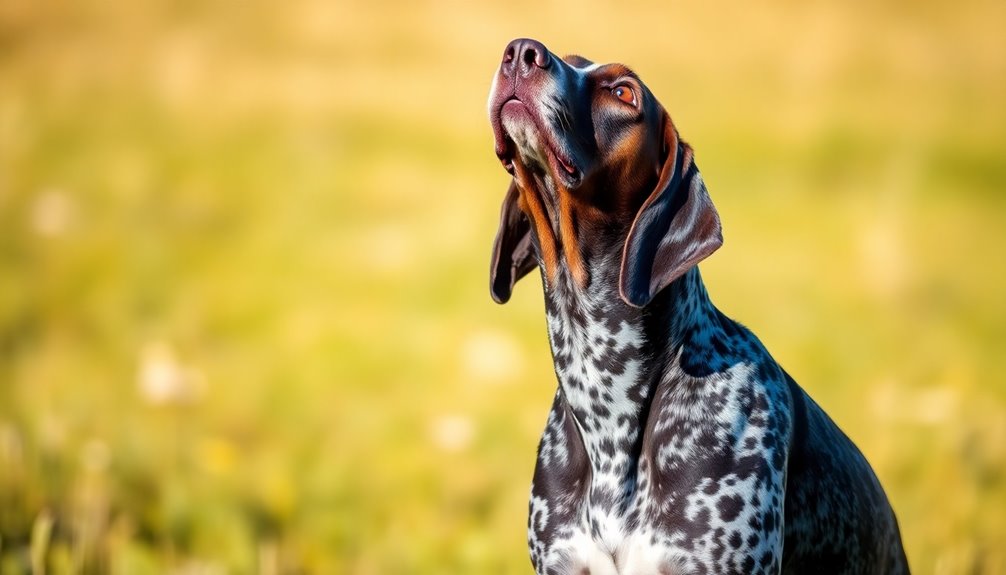
When you think of the Bluetick Coonhound, their impressive vocal talent for baying stands out alongside their strong scent-tracking abilities. This unique vocalization not only aids in hunting but also echoes through popular culture, as they've even starred in tales like 'The Hound of the Baskervilles'. Understanding their vocal skills can deepen your appreciation for this loyal breed. Their distinct vocal traits developed through selective breeding have made them exceptional communicators in the field.
Strong Scent-Tracking Abilities
Harnessing their remarkable anatomy, Bluetick Coonhounds excel in scent-tracking, making them exceptional hunters. With around 220 million scent receptors, compared to just 5 million in humans, these dogs are built for detecting even the faintest odors. Their long muzzles and large nostrils enhance their ability to smell, while their unique Jacobsen's organ processes pheromones effectively. Additionally, their long, floppy ears trap scent particles, bringing them closer to the nose for better detection. Bluetick Coonhounds can track scents over miles, whether hunting raccoons, deer, or other game. With stamina that allows them to cover vast areas, they can detect scents at levels as low as parts per trillion. This impressive capability is complemented by their enhanced anatomy, which is specifically designed for optimal scent detection.
Their innate abilities can be further developed through training, which is crucial for effective hunting. Early socialization and obedience help them learn commands, while scent trail exercises using raccoon fur sharpen their tracking skills. Positive reinforcement encourages their natural instincts, and participation in tracking competitions can improve accuracy by up to 70%. These traits make Bluetick Coonhounds invaluable partners in hunting and search-and-rescue operations.
Star of 'The Hound of the Baskervilles
The Bluetick Coonhound stands out not just for its tracking prowess but also for its incredible vocal talent, particularly its distinctive baying. This breed's unique howl serves essential roles during hunts, alerting you and other hunters to their progress. The deep, musical quality of their bay often evokes emotions ranging from excitement to nostalgia, making each vocalization a rich expression of their character. Additionally, as a breed that originated from French staghounds and English Foxhounds, their vocalizations reflect their diverse heritage.
When you're out in the field, their baying signals when they've treed prey, helping you locate them even in dense forests. This long-distance communication is crucial, as it allows you to follow their pursuit without visual contact.
However, managing their vocal talents outside of hunting requires some effort. Understanding the different vocal cues is key to meeting their needs, and positive reinforcement training can help control excessive barking.
Beyond hunting, the Bluetick's vocalizations can provide therapeutic benefits, offering companionship and evoking a sense of calm. Their expressive baying strengthens your emotional connection, making them not just loyal hunting partners but also cherished companions in everyday life.
Active Lifestyle Compatibility

If you love the outdoors and lead an active lifestyle, a Bluetick Coonhound could be your perfect companion.
These dogs thrive on regular exercise and require a good time commitment for training to harness their energy positively. With a need for 90 minutes of exercise daily, get ready for long walks, jogs, and engaging activities that keep both you and your pup happy and healthy. Additionally, participating in popular activities like hiking and fishing can create memorable experiences for you and your Bluetick Coonhound.
Ideal for Outdoor Enthusiasts
For those who thrive in an active lifestyle, the Bluetick Coonhound is an exceptional companion ready to join your outdoor adventures. This breed needs about 90 minutes of exercise daily, making them perfect partners for long walks, jogs, or hikes. Their natural stamina and endurance excel in outdoor activities, so if you enjoy exploring nature or hitting the trails, your Bluetick will thrive alongside you.
Engaging in activities that mimic traditional hunting tasks, like tracking exercises, keeps them mentally stimulated and physically fit. They love participating in coonhound events, interactive play like fetch, and agility exercises. Regular physical activity is essential; it helps them stay calm and content indoors. With their strong hunting instincts, it's important to have structured activities that channel their energy constructively. Incorporating risk-taking activities, such as navigating challenging terrains, can also enhance their outdoor experience and strengthen your bond.
You'll need to ensure a secure, fenced area for them to explore safely, as their strong prey drive may lead them to pursue enticing scents. Including your Bluetick in family outings not only meets their exercise needs but also satisfies their desire for companionship.
With modern technology like GPS tracking, you can enjoy outdoor adventures without worrying about their safety. Embrace the outdoors together, and your Bluetick Coonhound will be a loyal, spirited companion every step of the way.
Time Commitment for Training
Engaging in outdoor activities not only fulfills a Bluetick Coonhound's exercise needs but also sets the stage for effective training. To keep your pup happy and well-behaved, plan for at least 90 minutes of exercise daily. Activities like hiking, jogging, or agility training are perfect for channeling their high energy levels. Always keep them on a leash or in a fenced area to prevent them from following enticing scents.
Remember, mental stimulation is just as important as physical activity. Incorporate puzzle toys, scent work games, and interactive challenges to keep their inquisitive minds engaged. Activities like hide-and-seek or obstacle courses can enhance both their learning capacity and your bond with them. The Bluetick Coonhound's strong hunting instinct means they thrive on activities that engage their natural tracking abilities. Educational toys, such as STEM toys, can also provide mental challenges that stimulate their cognitive growth.
Training should be engaging and based on positive reinforcement. Use treats, praise, and play to encourage good behavior. Consistency is crucial; make sure commands and expectations are clear.
Early socialization helps reduce fearfulness and aggression, so expose your Bluetick to different people, environments, and animals.
Lastly, be patient and adaptable. Each dog has a unique personality, and training may require varied approaches. If needed, don't hesitate to consult a professional trainer to ensure you're on the right path.
Frequently Asked Questions
How Much Exercise Does a Bluetick Coonhound Need Daily?
Your bluetick coonhound needs at least 30 to 60 minutes of exercise daily, but ideally, aim for 60 to 90 minutes.
Activities like brisk walks, jogs, and hikes will help burn off their high energy. Incorporate games like fetch and agility training to keep them mentally stimulated.
Regular exercise prevents boredom and destructive behaviors, enhances their well-being, and gives them a sense of security, so keep them active and engaged!
Are Bluetick Coonhounds Good With Children and Other Pets?
Yes, Bluetick Coonhounds are generally great with children and other pets, especially if they're properly socialized from a young age.
They show patience and protective instincts towards kids, making them playful companions. However, due to their size and strength, you'll need to supervise playtime.
When it comes to other pets, they can coexist well if introduced carefully, but keep an eye on them around smaller animals due to their prey drive.
What Are Common Behavioral Issues in Bluetick Coonhounds?
Common behavioral issues in Bluetick Coonhounds include stubbornness during training, which can make them difficult to manage.
Their strong prey drive may cause distractions, leading to short attention spans.
You might notice separation anxiety when they're left alone, resulting in destructive behaviors.
Additionally, they can be excessively vocal, especially if bored or lonely.
Ensuring regular exercise and mental stimulation is important to prevent these issues from escalating.
Consistent training helps too!
How Can I Groom a Bluetick Coonhound Effectively?
To groom your Bluetick Coonhound effectively, brush their coat 2-3 times a week with a hound glove or medium-bristle brush.
Bathe them every 4-6 weeks, using a dog-specific shampoo.
Check their ears weekly for dirt and trim nails monthly.
Use lint rollers for quick clean-ups, and vacuum high-traffic areas regularly to manage shedding.
A balanced diet rich in essential fatty acids will also help maintain a healthy coat and skin.
Do Bluetick Coonhounds Have Any Specific Dietary Needs?
Yes, Bluetick Coonhounds have specific dietary needs. You should provide high-quality dog food rich in proteins to maintain their muscle mass and energy levels.
Balance carbohydrates and fats to avoid weight gain, and stick to age-appropriate options. Portion control is vital to prevent obesity, so divide their meals into two daily servings.
Regularly monitor their intake and consider fresh food for better digestibility, always avoiding people food for a consistent diet.
Conclusion
In conclusion, the Bluetick Coonhound is a loyal and spirited companion that thrives in active environments. With their unique blend of charm, intelligence, and strong instincts, they make excellent partners for those who love the outdoors. By understanding their needs for training, socialization, and exercise, you'll create a fulfilling life together. If you're ready for an energetic and affectionate friend, the Bluetick Coonhound could be the perfect addition to your family!

